
 |
|||||
|
|
|||||
|
|
|
|||||
|
|
CALVILLE ROUGE D’ÉTÉ A very ancient apple, probably French, and one subject to much confusion over the centuries, which has acquired nearly 150 synonyms. It has been suggested that it might even be the ‘Syrique’ of Pliny in the 1st century, though this is unlikely. It first settled with the name of Calville Rouge D’Été, in France in the 17th century, though it is believed to be 16th century. It was first known in England with the name Red Calvil in the 17th century. By the 18th century it received several references in Britain under different names, such as Summer Calville. J.Gibson in ‘The Fruit-Gardener: Containing The Method of Raising Stocks…’ in 1768, says for both summer calvilles (white and red) “the trees are rather delicate, and apt to suffer from the colds in Spring that so frequently happen in Scotland. They are tolerably good bearers”. The Reverend William Hanbury of Church-Langton, Leicestershire, in ‘A Complete Body of Planting and Gardening’ in 1770 says, under Summer Calville “is a fine large fruit, elegantly stained with red on the side next the sun. It ripens soon after the former (Summer Rembourge), and is in great request for the table.” Also writing of both were Rogers (1837), Scott (1872) and Hogg (1884). Ronalds and Lindley (both 1831) wrote only of Calville Rouge D’Été. The great French pomologist, Duhamel, writing in 1768 in ‘Traité des arbres fruitiers’ described Calville Rouge D’Été (under Calville D’Été) as being globular, a little conical, and with slightly prominent ribs the length of the fruit. Its skin is pale red, almost all over, with a few long streaks of a deeper colour, especially in the sun. The flesh is snowy white, with scent a little sourish and quite pleasant, but tending to become woolly when past its ripeness, at the end of July or early August. Lindley, Scott and Hogg had broadly similar descriptions with the suspicion that the last two borrowed from the first. They seem to think of it as it a culinary apple, though Ronalds had said it was a rich dessert apple. The fruit is medium sized, conical and ribbed, (though the ribbing can vary), with a prominent eye, which is small and set in a narrow crinkled basin. The stalk is an inch or more long in a deep narrow cavity. The skin is yellowish white in the shade, with thin streaks of red, and pale red (or shining crimson) in the sun, with darker streaks and some writers say there are prominent spots or lenticels. The flesh is white, sometimes tinged with red, tender, crisp and has a hint of strawberries. Fruit is ripe from July to August. It was not mentioned in Britain after the 19th century, and appeared to have been lost here, though it has still been known in Europe and in America. In 2010 we obtained scions from America and the fruit from our trees are fully in accord with Duhamel. A very good dual purpose apple, for an early fruit. Pollination Group 4. |
|||
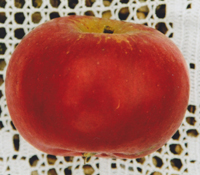 |
CALVILLE ROUGE PRÉCOCE An old French apple first known in England in 1826. It has wrongly been assumed to be only a synonym of Reinette Rouge Étoilée in recent times. Scions were brought to us by Nick Houston, who was close to the Allgrove family at Middle Green, Buckinghamshire. The famous Allgrove’s Nursery never listed this apple, but Jim Allgrove grafted a dozen trees and Nick Houston rescued cuttings when Jim Allgrove died and the nursery closed. A bright red, round and uniform apple, ripening earlier than Calville Rouge D’Automne, often in late August but usually in September. It is a good eating apple –crunchy and juicy, with a good flavour, which also cooks well, to a sweet yellow purée. It is often tinted red under the skin. The apples last for a couple of months. Pollination Group 4 |
|||
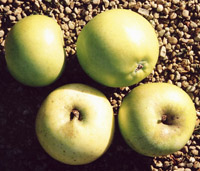 |
CAMBRIDGE
PIPPIN An old variety and old tree, owned by Alan and Ann Herring
of Pavenham, Bedford, who brought apples to us in 2006. It is not the
‘lost’ Cambridge Pippin of Thomas Rivers and not the Cambridge
Pippin that is a synonym of Bedfordshire Foundling. Their house was built
in the 1760s and always had an orchard attached. The tree appears to be
at least 100 years old, though possibly very old. The name of this apple
was passed on by a family friend, Mr Horace Church, who died several years
ago in his mid-eighties. He was a countryman and smallholder, very precise
in his knowledge and naming of fruit varieties. He knew the orchard in
1910 as a child and told a good tale of how, during World War I, he scared
birds from the fruit with gravel in his shotgun. Being under-age, he was
allowed powder but not shot! In our previous catalogue we have suggested
that this apple is only for culinary use, being a bit sharp. However,
in some years, if left late before picking, it becomes a very good eating
apple, with sweet, rich, juicy flesh, especially after storing for a while.
As a cooking apple it needs little or no sugar or water and quickly purées
in a pan or under light microwave. A medium, sometimes large, green apple,
turning yellow when kept and sometimes developing pale amber flecks. It
is ripe from late-September to late October and will stay juicy and keep
its flavour to the end of the year. Pollination Group 4 |
|||
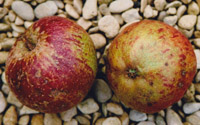 |
CAMBRIDGE
QUEENING Known since the start of the 20th century but older,
and believed to be from Cambridge, Gloucestershire. A culinary and dessert
apple that has also been used as a cider ‘sharp’. In most
years it might not develop fully into a good eating apple, but seems to
be inclined to do so in our hotter summers, when, in October, it is sweet
and with an excellent flavour, though not that juicy. It can be used earlier
as a juicy cider apple. When cooked it softens quickly and completely,
with a good flavour and no need for added sugar. The fruit varies in shape,
sometimes it is irregular and ribbed, sometimes more rounded, with striking
stripes, flecks and patches of dark red. Patches of russet are variable.
The fruit will last into January, remaining sweet. Pollination Group 5
|
|||
 |
CAMBUSNETHAN
PIPPIN There are different provenances for this old and excellent
Scottish apple. Hogg said that it originated at the ancient Cambusnethan
Monastery in Stirlingshire, and that it was much valued in Scotland, where
it was called ‘Cam'nethan Pippin'. Bunyard said it arose around
1750 when raised by Mr Paton, gardener at Cambusnethan House, Stirlingshire.
The local distinctiveness charity ‘Common Ground’ have suggested
it was raised near Wishaw in Clydesdale, Lanarkshire. It could be a quite
ancient apple. Both Hogg and Bunyard suggest it is less suited to southern
Britain where it may be second rate, but we contest that. It is excellent
with us. A small to medium sized apple with pale lemon yellow skin and
broken crimson streaks on the side next to the sun, sometimes with an
orange flush. There is some russet over the base and around the stalk.
It has a distinctive wide, open eye. The flesh is 'tender and juicy, with
a mild acidity', according to Hogg. This does not do it justice. The flavour
is very rich, sweet, juicy and with a perfect balance of acid. It has
been used in cooking, but it is really a full dessert apple. In Scotland
it is ripe in October and stores to January, while in the south it is
often ripe in late September and lasts only to Christmas. Part tip bearing,
but quite willing to form spurs. Pollination Group 5 |
|||
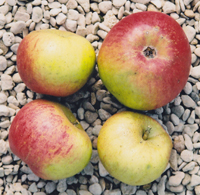 |
CAPPER’S
PEARMAIN Another old apple, extinct in Britain but reintroduced
by us from the Grove Research Station, Tasmania, collection of Heritage
Apples in 2005. It is an old Sussex variety first recorded in 1826 (JRHS)
and not known in Britain after the end of the 19th century. It is a very
late ripening dessert apple, medium to large in size, flattened round,
with pale green skin, turning gold, overlaid with many pink flecks and
broader scarlet streaks. It is quite an attractive apple. The apple is
heavy, with dense flesh that is sweet rich and juicy when ripe, but keeps
a lot of sharpness until that time. Some who like a sharp apple will enjoy
this before fully ripe. Others must wait until late in the year. Pollination
Group 4 |
|||
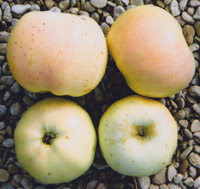 |
CAPTAIN
PALMER An old and very good Norfolk dessert apple, of uncertain
age. We were given scions by John and Helen Hempsall of Nottinghamshire,
who acquired it from the old Ranworth Nursery. It came with a reported
origin in 1620, but this seems an implausibly precise and early date and
other modern sources put the date at pre 1900, with an origin as a seedling
from Gissing, near Diss, Norfolk. It is ripe at the end of September to
mid October and will still be in good condition in early December, under
good storage. The uniformly rounded apple has clear skin of pale yellow,
blushed light amber. The flesh is sweet, crisp, juicy and crunchy with
a very pleasing flavour. Free spurring and a good cropper. Pollination
Group 5 |
|||
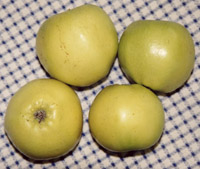 |
CARLISLE
CODLIN A highly respected and much planted cooking apple from
Cumbria. The earliest historical reference to it was in a list of Alexander
Forbes, gardener at Levens Hall Nursery, Kendal, Cumberland, in 1820.
Perhaps the most complete and colourful description comes from Hogg. ‘Fit
for use when no larger than a walnut, and after attaining their growth
continuing in perfection as late as Christmas. If blanched in warm water,
when used small, the outer rind slips off and they may be baked whole;
their colour is then a transparent green; and their flavour is exquisite,
resembling that of a green apricot. When it is about the size of a large
nutmeg, it may be made into apple marmalade, or a dried sweetmeat, which
rivals the finest Portugal plum’. John Turner, Assistant Secretary
to the London Horticultural Society, said, in a report in 1819, of apples
exhibited in 1818, “This, though not large, is a most desirable
kitchen apple, possessing a very superior flavour when dressed. It has
a peculiar quality in being fit for tarts and for codling in its most
early state.” The mature fruit is angular on the sides and flat
at the base. The skin is smooth, 'unctuous' and pale yellow, with a few
russet specks. The flesh is tender, crisp and juicy, 'with a fine, brisk,
and sugary flavour'. An abundant cropper and a modest sized tree. Pollination
Group 3 |
|||
 |
CAROLINE
Said to be a dual purpose apple, dating from before 1822, but it is not
a willing cooking apple. It is believed to have originated in the garden
of the second Lord Suffield of Blickling and Gunton Hall, Norfolk and
was named after his wife, Caroline, Lady Suffield. It was in the London
Horticultural Society collection in 1826. The apples are medium sized,
deep yellow when ripe with streaks of bright crimson, round and slightly
flattened. The flesh is firm, juicy, very richly flavoured and, when fully
ripe, is a very sweet and pleasant dessert apple, with hardly any acid.
It has also been used as a sharp/bittersharp cider apple, when gathered
under ripe. It ripens in October and November but does not last well,
without becoming mealy. Our thanks to John and Helen Hempsall for sending
scion-wood. Pollination Group 5 |
|||
CASSOP
WAYFARER Every now and then we learn of a single ancient apple
or pear tree whose location makes no sense because it is far from dwellings
or old orchards, until we observe that it lies on some ancient way and
was surely planted or left to flourish as a wilding to provide food to
ancient travellers or to be a marker along the route. This is just such
a tree and we first learned of it when Ann Copeman sent us details and
photos in 2020. Cassop and Cassop Vale are quite close to Durham City.
The tree is at the very edge of a farmer’s field and enclosed by
a fence, the tree overhanging the ancient travellers’ route adjacent.
We say ‘is’ but the tree was brought down in November 2021
by Storm Arwen and fell across the route. We did not know the fate of
this tree, but it would surely have had to be cut back from the ancient
route leaving little if any remaining. Storm Arwen was particularly cruel
to County Durham as the crown of the Croxdale Crab was broken off, though
it survives and is re-growing. The Cassop tree was about 10 foot in girth
at the base, hollow, with a large bushy crown and a huge crop of fruit
when Ann first encountered it. The fruits were smallish, mostly yellow
and with a delicious cidery taste, the scent pervading the whole area.
The cows in the field had eaten as much as they could, and the ancient
way was carpeted with apples. The tree was over 40 feet tall. Ann researched
both the area and the ancient travellers’ route, between the port
of Hartlepool and the city of Durham, part of the network of waymarked
Northern Saints’ Trails, which converge on Durham Cathedral. King
Canute is recorded passing this way in the year 1020, and pilgrims both
from, and to, the continent would have taken this path, along with merchants
etc. Cassop Vale is thought to derive its name from the Anglo Saxon for
‘valley of the wild cat’, once the hunting grounds of Durham’s
powerful Prince Bishops. It is now an SSSI. Ann has “always thought
of this tree as the Wayfarer’s Apple, rooted in its place, giving
fruit and shelter to the multifarious tide of travellers and itinerants
who made their ways past it through the centuries”. Ann has suggested
the name of Cassop Wayfarer, which seems perfect to us. Ann sent us apples
in early November 2020 by which time most were bruised and going off.
They were rather small, but the tree was having a major crop and had not
been pruned for many years, so we would expect the apples to be larger
when grown normally. They were yellow, some a bit oblong and probably
at their best a few weeks before. They were going softish but were still
juicy and very good – lemony and sweet with a rather unusual but
pleasing flavour. This apple will be very good when larger and fresher
and the scent is very strong, as Ann observed. The tree was so close to
the corner of the field and fence that there would have been almost nothing
left of the trunk once the public path was cleared. We hoped that the
owner had not removed what remained. Though the old trunk was dead and
decayed on one half, there was living cambium within, which had rounded
off and would have become new trunks. The other half of the trunk was
still alive and could also have generated new trunks. There was not enough
space for the trunk to fall and root again from it. This ancient tree
was feared lost. Thankfully, Ann had sent cuttings for grafting in early
2021 and though she was only able to reach some very old, thin wood, hardly
likely to succeed in grafting, we performed our usual miracles and thanks
to Ann the apple variety, at least, was safe for posterity. However, the
original tree lives on! Ann recently returned to Durham and visited the
tree. She sent us more photos. The owner had very astutely left the remains
of the split and decayed trunk which contained the rounded off, detached
and regrowing new trunk, within the old trunk. The old trunk still leans
at a precarious angle and should be propped securely to avoid future wind
and gravity damage to the re-growing small new trunk, but given time the
original tree should return to a new and long life. It would already appear
to be over 200 years old. It still has a very extensive root system and
should grow very rapidly. We hope to post the many photos that Ann sent
of this tree on our website, in a wider article. The owner of this tree
has been hard to discover but if they should read this and wish to get
in touch (or anyone else with knowledge of this tree) then we would love
to hear. Poll ? |
||||
|
||||